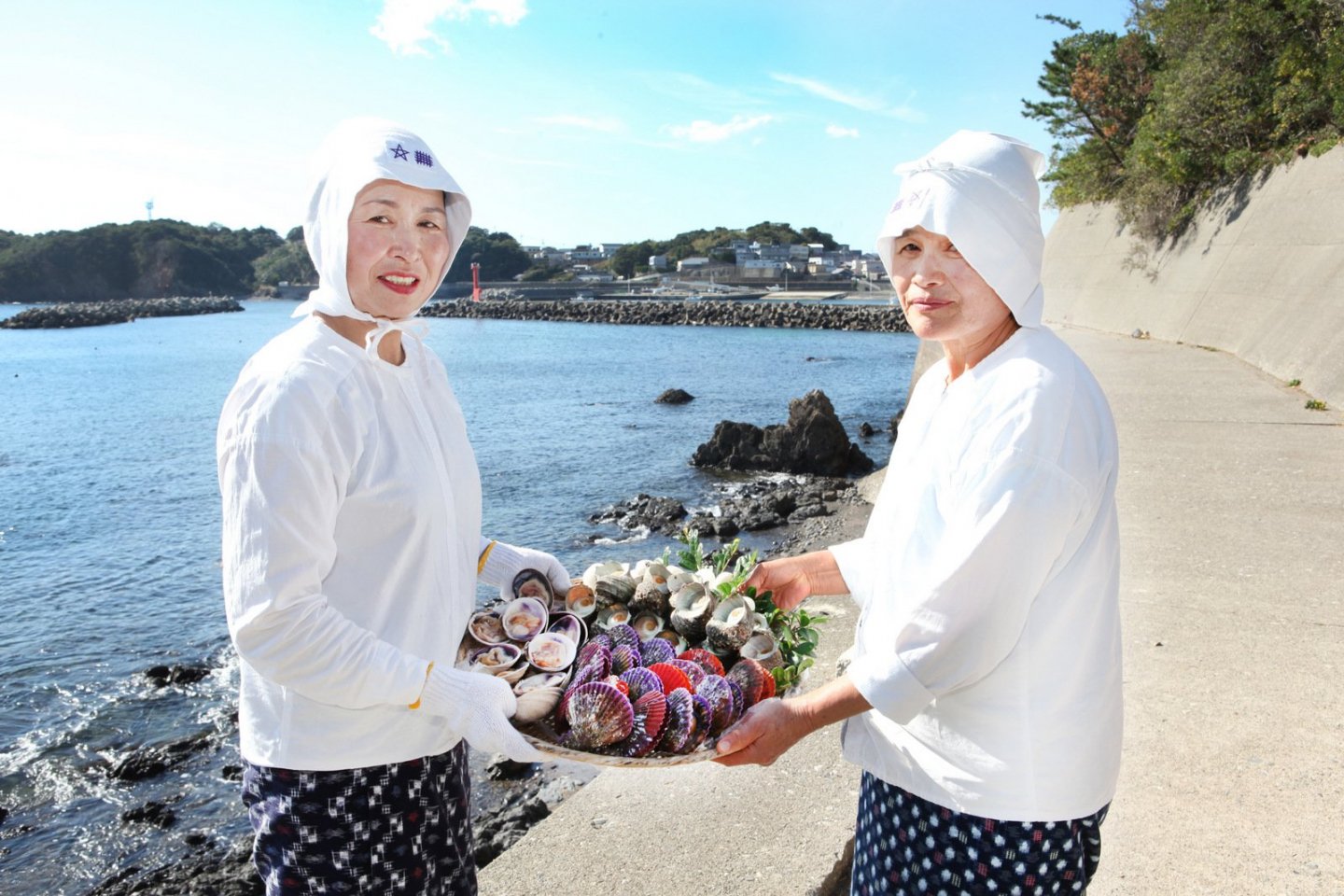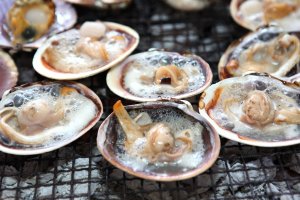Meet Japan’s female free divers at an Osatsu Kamado ama hut in Toba, and learn about the ancient and fascinating culture of this abundant coastal area. Eat delicious freshly caught seafood, and visit Mikimoto Pearl Island and Ise Jingu Shrine in the same trip.
Toba lies on the upper edge of the Shima Peninsula which curves out into the ocean like a fish hook from the coast of Mie Prefecture. The Toba region faces Ise-Shima Bay and the Pacific Ocean, and much of Toba falls within Ise-Shima National Park which protects the area’s coastline and densely forested hills and mountains. The land’s edge is fractured by myriad bays and inlets, and the sea is studded with scattered islands. Beautiful ocean views, abundant nature and delicious fresh seafood draw visitors from all over. The area is home to many of Japan’s ama, female free divers. Natural hot springs supply luxurious onsen ryokan hotels, which are the ultimate in Japanese travel accommodation. Toba is also the first place in the world where pearls were successfully cultured.

Toba environment
The branch-like forms of the inlets around Toba are known as rias. Ria coastlines are formed when river valleys are submerged, either by rising sea levels, or through the land sinking due to plate movement. Mineral-rich silt is carried by rivers from the mountains into the sheltered bays. As a result this corner of the ocean is especially fertile and teeming with sea life. Lush forests of seaweed cover the sea floor, home to all manner of ocean creatures.

Wonderful seafood
People have enjoyed the abundance of seafood here since the dawn of Japanese history. Delicious spiny lobster (crayfish) is just one of the local delicacies to delight seafood lovers. Abalone, oysters, scallops, turban snails, sea urchins and other shellfish are also highly prized. Of course you can eat wonderfully fresh sashimi in Toba’s restaurants and ryokans. On the area’s largest island, Toshijima, you can see vast amounts of whitebait spread on netted trays to dry in the sun. Sea vegetables are also gathered here, especially wakame seaweed.
A fishing community
For centuries the Ise-Shima-Toba area has supplied the finest seafood for the Shinto priests of Ise Shrine. There is a thriving commercial fishing industry here, and plenty of aquaculture too. A walk around the docks will reveal piles of nets, stacks of octopus pots and other fishing paraphernalia. Out on the water you can see the rafts of oyster beds for cultured pearl production. About 750 ama dive for seafood and pearl oysters around the Toba area, around half of the total number of ama divers in Japan.

Things to See and Do in Toba
Ise Jingu Shrine

Impressive Ise Jingu Shrine is one of Japan’s most famous and holy Shinto shrines. Actually a complex with many shrines, it is dedicated to Amaterasu-Omikami and Toyouke-Omikami. The high priest or priestess of Ise Jingu Shrine must be a member of Japan’s Imperial Family.
Mikimoto Pearl Island
Kokichi Mikimoto first invented his process to culture pearls in Toba. On Mikimoto Pearl Island visit a museum and learn all about the process of culturing pearls, enjoy an exhibition of antique pearl jewelry, and also see real ama divers in action.
Ishigami-san - the women’s shrine
For centuries ama divers have prayed for protection and good catches at Ishigami-san Shrine in the small seaside area of Ōsatsu. Ishigami-san is dedicated to Tamayori-hime Mikoto who protects women. Women come from all over Japan to pray here, and it is believed that Tamayori-hime Mikoto will grant one wish to every female visitor! You can also buy omamori (lucky charms) here with the Doman Seman symbols associated with ama divers.
Two Festivals and a marathon
Three special events attract many visitors to Ōsatsu every year. The Ishigami-san Women’s Marathon is held in February each year. The 10 kilometer run along the Toba coastline began after female marathon runner Mizuki Noguchi won a gold medal at the 2004 Olympic Games in Athens after praying at Ishigami-san and carrying an Ishigami-san lucky charm.
The Ishigami Spring Festival takes place on May 7th, when ama divers and the community pray for a good fishing season. On this day men also show appreciation for women by cooking and doing housework.
Ousatsu Tenno Whale Festival takes place on July 14th. According to local legend, Kannon, Goddess of Mercy, was once seen riding on a whale, so this festival is held to pray for both safety at sea and a plentiful catch. A portable shrine shaped like a whale is carried through the streets, then ama divers carry it into the ocean where it is towed out to sea by boat. It is followed by a firework display in the evening.
Partake in genuine ama culture
One of the most interesting activities Toba offers is visiting an ama hut. The ama community is a close knit group with their own unique and fascinating culture, traditions and rules. One of their customs is to maintain a amagoya or ‘ama hut’ where they gather to relax and spend time together after diving.

Ōsatsu Kamado is one such ama hut, and you can arrange to go there and meet the divers in person. They will explain their customs, tell stories - and they have a lot of interesting stories to tell - and show you the equipment they use. You will also get the chance to dress up in traditional white ama diving costume and take photos with the real ama.
The whole experience takes about an hour, and costs ¥3,500 per person. You can choose a time to suit between 11:30 am - 2:00 pm. A delicious char-grilled seafood lunch freshly caught by the divers will be served. It includes turban shell, short-neck clam, noble scallop, mochi (rice cake), dried mackerel, arame seaweed side dish and sea urchin rice. If you want you can arrange to eat Ise lobster (crayfish) and abalone for an extra charge of ¥2,500 - ¥3,000yen. There is also a children’s menu without shellfish available for ¥1,000
Alternatively there are 10am or 3pm options for ¥2,000 per person. A light snack of green tea, grilled mochi (rice cake) and shellfish will be served
How to book an Ama Hut Experience
To make a reservation and see comprehensive access information visit the Ōsatsu Kamado website (English, Chinese and Japanese). Bookings must be made before 5pm the day before.

































